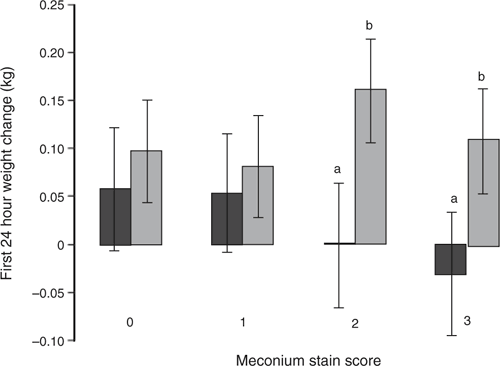Inclusion of MgSO4 in the diet of sows before farrowing improves measures of piglet colostrum ingestion
K. J. Plush A B C , L. M. Staveley B , A. C. Weaver B and W. H. E. J. van Wettere BA South Australian Research and Development Institute, Roseworthy, SA 5371.
B The University of Adelaide, Roseworthy, SA 5371.
C Corresponding author. Email: kate.plush@sa.gov.au
Animal Production Science 55(12) 1476-1476 https://doi.org/10.1071/ANv55n12Ab038
Published: 11 November 2015
Colostrum ingestion is one of the most important factors contributing to piglet survival (Devillers et al. 2011). Hypoxia during parturition may reduce the amount of colostrum consumed, and neuro-protective agents could provide a simple method of increasing the viability of piglets that have suffered oxygen deprivation during the birth process. Magnesium ions reduce cell death after a hypoxic event (Marret et al. 2007), hence magnesium sulphate (MgSO4) may be a suitable candidate for inclusion in a sow diet before farrowing. It was hypothesised that sows supplemented with MgSO4 would give birth to piglets with improved vitality and increased colostrum ingestion.
Sows (parity 2 to 9) were fed 3.0 kg/d of a control lactation diet (Control; n = 30) or a diet supplemented with 21 g/d of MgSO4 (Mg; n = 31) from 5 d before farrowing. Piglet measurements (n = 758) collected from sows that farrowed between 0600 and 2200 h included meconium stain score to indicate hypoxia (0: no staining, normoxic to 3: severe staining, hypoxic), vitality score (0: no movement, no breathing after 15 sec to 3: good movement and breathing, piglet attempts to stand within 15 sec), first 24-hour weight gain, blood glucose concentration and estimated piglet serum IgG content (immunocrit; Vallet et al. 2013) at 24 hours of age. Non-normally distributed data were transformed and subsequently analysed using a linear mixed model (Genstat, 16th Edition; UK) with sow identification fit as the random term. Data presented are least square means ± SEM.
There was a tendency (P = 0.08) for all piglets from the Mg treatment to display a higher vitality score immediately after birth (1.6 ± 0.1) than Control piglets (1.4 ± 0.1). Piglets from the Mg treatment tended (P = 0.07) to have higher blood glucose levels (5.9 ± 0.3 mmol/L) than Control piglets (5.3 ± 0.4 mmol/L) at 24 hours of age, but immunocrit measurement remained unaffected (P > 0.05). Piglets from the Mg treatment that received a meconium stain score of 2 or 3 gained weight over the first 24 hours (P < 0.01) whilst Control piglets within these scores effectively did not gain weight (Fig. 1).

|
Given that weight gain in the first 24 hours is indicative of colostrum uptake in piglets (Devillers et al. 2011), our data show that the inclusion of MgSO4 in a pre-farrow sow diet assists meconium stained piglets to consume colostrum. There was also some evidence of improved vitality and energy levels across all MgSO4-treated piglets. Further work should determine if these improvements result in increased piglet survival.
References
Devillers N, Le Dividich J, Prunier A (2011) Animal 5, 1605–1612.| Crossref | GoogleScholarGoogle Scholar |
Marret S, Doyle LW, Crowther CA, Middleton P (2007) Seminars in Fetal & Neonatal Medicine 12, 311–317.
| Crossref | GoogleScholarGoogle Scholar |
Vallet JL, Miles JR, Rempel LA (2013) Veterinary Journal (London, England) 195, 91–97.
| Crossref | GoogleScholarGoogle Scholar |
This work was conducted using funds from the DAFF Science and Innovation Award sponsored by Australian Pork Limited.


 ) and those supplemented with 21g/sow/day of MgSO4 (Mg) (
) and those supplemented with 21g/sow/day of MgSO4 (Mg) ( ) prior to farrowing for piglets ranging from a meconium score of 0 (normoxic) to 3 (hypoxic).
) prior to farrowing for piglets ranging from a meconium score of 0 (normoxic) to 3 (hypoxic).